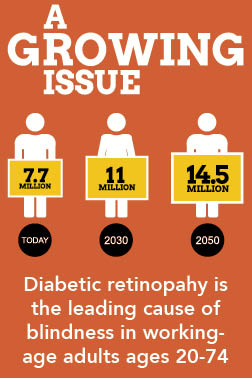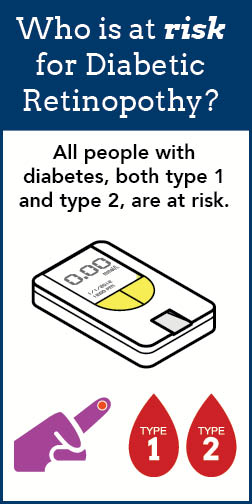Your body can be affected by diabetes in many ways. It can affect your vision by causing cataracts, glaucoma, and damage to the blood vessels in your eyes. People with untreated diabetes are said to be 25 times more at risk for blindness. The longer you have diabetes, the greater the risk of developing diabetic retinopathy. Located conveniently in Fayetteville and Rogers, Arkansas, the doctors and eye care professionals at McDonald Eye Associates are experienced in treating all types of diabetic retinopathy.
Types of Diabetic Retinopathy
An early stage of diabetic retinopathy is background diabetic retinopathy. In this stage, small blood vessels leak in the retina causing swelling, and deposits called exudates form. Sometimes the leaking fluid can take place in the retina causing macular edema. When the macula becomes involved it can affect your vision and close work.
Proliferative Retinopathy
When new, abnormal blood vessels begin growing on the retina it is called proliferative retinopathy. The abnormal blood vessel growth is referred to as neovascularization. These new blood vessels are weak, often causing them to break and bleed inside the eye. When bleeding occurs, it blocks the light entering the pupil towards the retina causing blurred vision. The new abnormal blood vessels may grow scar tissue that pull on the retina which can cause a retinal detachment.
Symptoms of Diabetic Retinopathy
The symptoms of background diabetic retinopathy usually go unnoticed until you have an eye exam or when there has been a significant loss in vision. Proliferative retinopathy usually causes hazy, spotty, painless changes in your vision which needs immediate medical attention.
How is diabetic retinopathy diagnosed?
Frequent eye exams are extremely important in controlling any diabetic changes in the eyes. If diabetic retinopathy is found on an eye exam, a fluorescein angiography may be ordered to find out if treatment is needed. Fluorescein angiography is a test where dye is injected into the veins of your arm and photos are taken to see if there is any leaking of the blood vessels.
Laser surgery can be used to seal off the leaking blood vessels in the eye, which is called laser photocoagulation. If this type of surgery is performed at an early stage in diabetic retinopathy, it can slow down vision loss. Laser surgery can even help with proliferative retinopathy to help prevent severe visual impairment.
Cryotherapy is another treatment for diabetic retinopathy when laser surgery cannot be used. This procedure involves freezing parts of the retina to help shrink the abnormal blood vessel growth.
Vitrectomy surgery can be done in advanced cases of proliferative retinopathy. This procedure involves removing the vitreous, which is the clear jelly like substance in the center of the eye. The vitreous is removed due to a large amount of bleeding that has taken place.
In some cases of proliferative retinopathy, a retinal repair is needed. This surgery is recommended when the scar tissue has caused the retina to pull away from the back of the eye.
It is imperative for patients to take very good care of themselves to help with prevention of diabetic retinopathy. A patient should try to maintain good blood sugar levels, good blood pressure, and avoid smoking.




